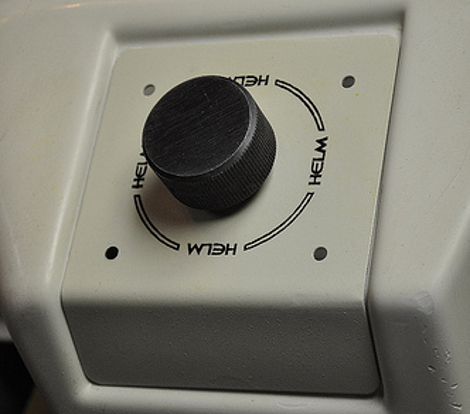
[Zitt] is sharing some methods he’s honed for color-matching powder coat paint. He developed these techniques while restoring a 1982 Star Trek coin-op machine. The image above shows a paddle used for the game. The plate that houses the control was beat up, and he needed to repaint it but wanted to make sure it didn’t look out-of-place with the molded plastic that surrounds it.
He gets his powder paints from Harbor Freight, a favorite depot for hackable goods (like drill motors, or metal carts). Usually these paints would be applied by attracting them to the piece using electrostatic charges. [Zitt’s] not doing that, but applying them with a paint sprayer instead.
The first step is to match your color. He’s using an electronic color matching device which gives data to plug into a chart on the web for a color match. Once you’ve got a formula, mix up the powder coat, and then dissolve it into some Methyl Ethyl Ketone. This goes into the spray gun and is applied in an even coat. Before heading into an oven for curing, it’s important to wait for this coat to dry. [Zitt] observed some boiling MEK on a wet test piece that left an undesirable texture on the baked paint after curing. After running a few test pieces he picked the blend that was the best match and then painted all of his restored parts.
















Nice one! Not that easy to avoid metamerism in color matching.
really cool but not that do-able for us DIYers on a budget. I know I’m not the only one that cant afford a 275$ color matching device.
“…boiling MEK…” possibly one of the scarier things I’ve read on HAD.
This is very well done and it looks like [Zitt] has really done some good work, but….
Powder coating was originally designed as a solvent-free coating method. If you add back solvent, aren’t you just reinventing paint? I realize that there’s a final cure of the thermoplastic/thermoset pigment material, but baked-on enamel has been around for some time as well.
This is very well done and it looks like [Zitt] has really done some good work, but….
Powder coating was originally designed as a solvent-free coating method. If you add back solvent, aren’t you just reinventing paint? I realize that there’s a final cure of the thermoplastic/thermoset pigment material, but baked-on enamel has been around for some time as well.
Also MEK is pretty flammable stuff – be careful, kids.
This doesn’t seem to be a sensible way of doing things.
Firstly, as has been stated, if you’re adding solvent to the equation, why use powder? As I understand it, the high durability of powder coat is that there is no solvent to evaporate from the applied finish, therefore the finish is a continuous film, and not (as with solvent based paints) microscopically porous.
Secondly, if you’re going to the trouble of getting exact data on the colour of the existing finish, why then use the closest RAL colour? The same outcome could be achieved with swatches.
I really hate to knock a project, but in this case I would have thought the best course of action would be to head to the paint supplier with the part and ask them to mix you a litre of matching paint.
On the other hand, this is HaD, so we should celebrate the method, not critise the outcome.
Fair points – however, I didn’t want to use Latex or any “paint supplier” method. It’s DIY which is the hole point of hackin’ right?
I’m not familar with “baked on enamel”.
And yes; while the Color cue can be expensive – it’s not required (note: I said it was optional)… you can mix it by eye if you want.
Maybe I’m just missing something; but getting an inexpensive paint match the whole point? I wanted the robustness of the powdercoat with the ease of paint mixing latex.
Hmmm, I agree with the rest of the above. Kudos for figuring out a great looking fix. It does seem to be reinventing the wheel a bit with the solvent addition but I’m no paint pro. I do know enough to echo the other sentiments of caution as well to anyone messing with paints and solvents. As a side note if ya do, warn your neighbors so they don’t think you are running a meth lab, like a crafter friend of mine ;)
whoa, wait a minute. Why are we are we discussing just his painting method? I mean from the first freaking page this guy is hacking an oscilloscope because he doesn’t have a proper vector monitor. check out the link, it’s got a little bit of something for everyone.
Zitt – I’m pretty sure you’re sacrificing powder coat durability when applying it in wet form. Nothing to worry about, as powder isn’t as durable as some people hold it up to be, but I’ve found 2k paints to be tougher than powder coat.
As always, the caveat is that preparation is everything.
I’m loving your method of getting the script onto the workpiece – truly fantastic work (and something I’m certain most powder shops wouldn’t be able to replicate!).
Oki nice thing…